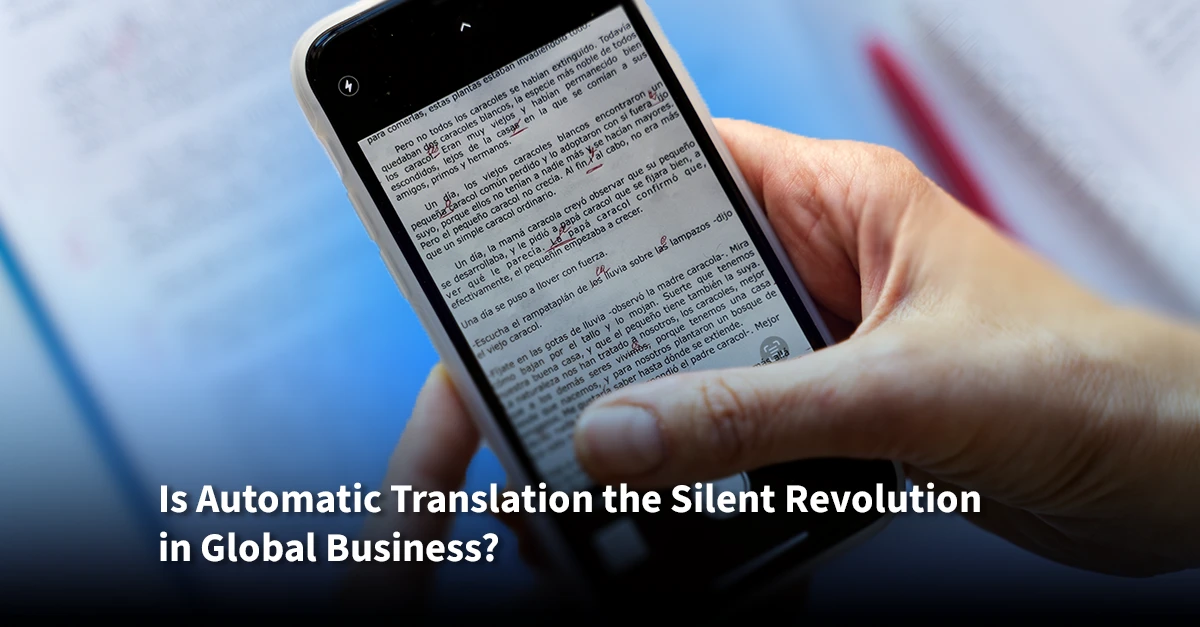Schedule a FREE call with our outsourcing expert now and get a precise quotation that meets your requirements. Don't wait - get started today!
How is automatic translation reshaping cross-border business communication? With machine translation now powering over 30% of professional translation services, are we witnessing a revolution in cross-border communication?
With artificial intelligence (AI) and machine learning advancements, you can instantly break language barriers and reach new markets confidently. Automatic translation isn’t just about swapping words from one language to another; it’s about understanding context, tone, and cultural nuances.
Whether expanding your business overseas or simply communicating with international clients, the correct translation software can make all the difference. Accurate, fast, and efficient—automatic translation opens doors to global opportunities.
Ready to take your business global? Explore how automatic translation tools can help you engage with new audiences and grow your brand beyond borders.
Automatic Translation vs Machine Translation: Understanding the Difference
Automatic and machine translation are often used interchangeably but have distinct meanings. It refers to the broader process of converting text using software from one language to another. Machine translation is a specific type of automatic translation that relies on algorithms to perform this task without human intervention.
Machine translation has evolved significantly, moving from simple rule-based systems to sophisticated neural networks that power advanced automatic translation today. Tools like Google Translate and DeepL are prime examples of how far this technology has come, offering faster and more accurate translations than ever.
How Automatic Translation Works: The Technology Behind It
Automated translation relies on cutting-edge technology to deliver fast and accurate translations. This technology’s core are algorithms, neural networks, and artificial intelligence (AI). These components work together to analyze and understand the context of the text, making the translation more accurate.
Machine learning plays a crucial role in improving automatic translation quality over time. These systems continuously refine their ability to translate text by learning from vast data. Additionally, translation memories help maintain translation consistency by storing previously translated text, which can be reused in future projects.
Key Benefits of Using Automatic Translation in Business
Automatic translation offers several significant advantages for businesses that expand their reach and streamline operations. Here’s a closer look at how it can benefit your business:
1. Cost-Efficiency
One of the most compelling reasons to use automatic translation is its cost-efficiency. Traditional translation services often involve high costs due to the need for professional translators, especially when dealing with large volumes of text. Automatic translation tools, however, can handle routine and high-volume translation tasks at a fraction of the cost. By automating the translation process, businesses can reduce their reliance on human translators for everyday communications and save on translation expenses.
2. Speed and Real-Time Communication
Automatic translation tools provide instant translations, which is crucial for businesses that operate in fast-paced environments. Translating text quickly allows real-time communication with international clients, partners, and stakeholders. This immediacy can enhance customer service, facilitate quicker decision-making, and improve overall responsiveness in global interactions.
3. Global Reach
Automatic translation helps businesses overcome language barriers, making it easier to connect with audiences worldwide. By translating content into multiple languages, companies can broaden their market reach and engage with potential customers in different regions. This capability is precious for marketing, e-commerce, and customer support, enabling businesses to tailor their messages to diverse linguistic and cultural groups.
4. Scalability
As businesses grow and expand into new markets, the volume of translation work often increases significantly. Automatic translation tools are designed to handle large amounts of text efficiently, making them ideal for businesses with scaling translation needs. Whether you’re translating product descriptions, user manuals, or marketing materials, automatic translation can manage these tasks seamlessly, allowing companies to scale their operations without being overwhelmed by translation demands.
5. Consistency and Standardization
Automatic translation tools often include features like translation memories and terminology databases that help ensure consistency across all translated content. Translation memories store previously translated segments, which can be reused in future projects to maintain uniformity in terminology and style. Businesses must uphold a consistent brand voice and message across various languages.
6. Enhanced Productivity
By automating routine translation tasks, businesses can free up valuable time and resources that can be better spent on core activities. Employees can focus on higher-value tasks, such as strategy development and customer engagement, rather than spending time on manual translations. This increased productivity can contribute to overall business growth and efficiency.
Automatic Translation Tools and Software: Top Picks for Businesses
Automated translation tools and software are essential for businesses to manage translation tasks efficiently and effectively. Here’s a concise overview of some of the top tools available:
1. Google Translate
- Overview: One of the most widely used translation tools, Google Translate, supports over 100 languages.
- Features: Offers text, speech, and image translation. Integrates with various apps and services for seamless use.
- Strengths: Broad language support and ease of use. Suitable for casual translations and quick communication.
2. DeepL
- Overview: Known for its high-quality translations and advanced neural network technology.
- Features: It provides text translation with nuanced understanding and context. The Pro version offers additional features like translation memories and glossary support.
- Strengths: Superior translation accuracy, especially for European languages. It is ideal for businesses needing high-quality translations.
3. Microsoft Translator
- Overview: A robust tool integrated with Microsoft Office and other Microsoft products.
- Features: Offers text, speech, and image translation. Includes real-time translation features and multi-language support.
- Strengths: Seamless integration with Microsoft products, suitable for enterprise environments and real-time communication.
4. SDL Trados Studio
- Overview: A professional translation software tailored for translation agencies and large enterprises.
- Features: Advanced translation memory, terminology management, and project management tools.
- Strengths: Excellent for maintaining translation consistency and managing complex translation projects.
5. Smartling
- Overview: A cloud-based translation management system designed for businesses.
- Features: Offers translation memory, glossary management, and workflow automation. Integrates with various content management systems.
- Strengths: Streamlines translation workflows and ensures consistency across multiple languages and platforms.
Challenges and Limitations of Automatic Translation
While automatic translation offers many benefits, it also has its limitations. One common issue is contextual errors, where the translation needs to capture the original text’s meaning entirely. Cultural nuances and idiomatic expressions can also be challenging for automatic translation tools to handle accurately.
Despite these challenges, human translators still play a crucial role in ensuring quality translations, especially for high-stakes content like legal documents or marketing materials. To mitigate potential issues, businesses can follow best practices, such as using a combination of automatic translation and human review to ensure the highest quality translations.
Choosing the Right Automatic Translation Solution for Your Business
Selecting the right automatic translation solution for your business requires careful consideration. Key factors include the target language, the type of content you need to translate, and any industry-specific requirements you may have. For example, some industries may require specialized vocabulary or higher accuracy.
Integrating automated translation tools into your existing workflows can be straightforward, especially with tools that offer easy integration with typical business applications. To evaluate the effectiveness of a translation solution, businesses should consider the quality of the translations, the speed of the tool, and how well it meets their specific needs.
Final Thoughts on Automatic Translation
Automated translation is a powerful tool that can significantly benefit businesses by reducing costs, increasing efficiency, and enabling global communication. However, while technology has made significant advancements, it’s essential to balance these tools with human expertise to ensure high-quality translations, especially for complex or culturally sensitive content.
Businesses can streamline operations and effectively reach international markets by selecting the right automatic translation solution.
Explore the wide range of automatic translation tools available and find one that best suits your business needs. Start using these technologies to expand your global presence today.
At Magellan Solutions, we combine advanced translation technology with skilled human translators to provide accurate and culturally relevant translations. Let us help you navigate the complexities of global communication and take your business to new markets. Contact us today to learn more about how we can support your translation needs.
















